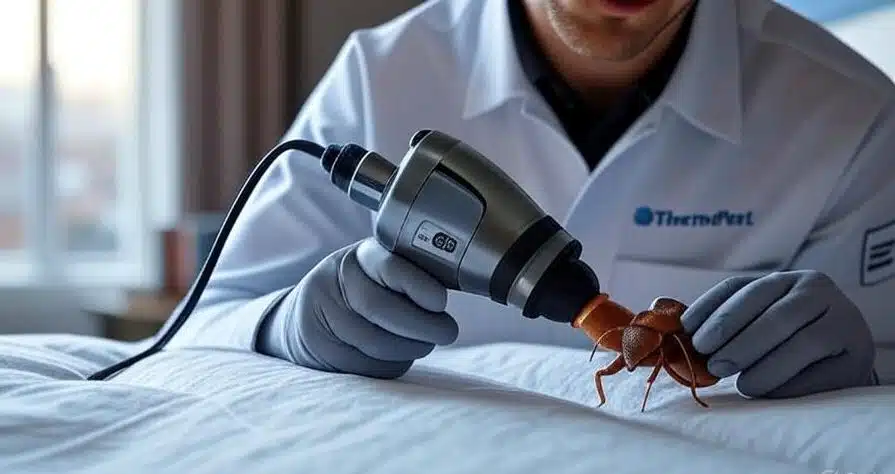Bed bugs are a persistent problem in London, thriving in the city’s bustling urban environment. For residents facing an infestation, knowing how to treat bed bugs UK effectively is crucial to reclaiming your home. This comprehensive guide, brought to you by ThermoPest, outlines proven methods to eliminate bed bugs, prevent reinfestation, and protect your London home, with practical advice tailored to the city’s unique challenges.
Understanding Bed Bugs in London
Bed bugs (Cimex lectularius) are small, reddish-brown insects that feed on human blood, typically at night. Their flat bodies allow them to hide in tiny crevices, such as mattress seams, furniture, or skirting boards. In London, factors like dense housing, frequent travel, and shared spaces in flats or terraced homes make bed bug infestations common, particularly in areas like Camden, Croydon, or Tower Hamlets.
Signs of an infestation include itchy red bites, blood spots on bedding, dark faecal marks, or a musty odour. Early detection is key, as bed bugs reproduce quickly, making treatment more challenging if delayed.
Why Bed Bugs Are Hard to Treat
Bed bugs are notoriously resilient due to:
- Longevity: They can survive up to 12 months without feeding in ideal conditions.
- Hiding Ability: Their small size and preference for tight spaces make them difficult to find.
- Resistance: Some bed bugs have developed resistance to common insecticides, complicating DIY treatments.
These traits mean that understanding how to treat bed bugs UK requires a strategic, multi-faceted approach, often combining DIY efforts with professional intervention.
Step-by-Step Guide to Treating Bed Bugs
Effective bed bug treatment involves preparation, elimination, and prevention. Here’s how to tackle an infestation in your London home:
Step 1: Confirm the Infestation
Before treatment, verify the presence of bed bugs:
- Inspect mattresses, bed frames, headboards, and furniture for live bugs, shed skins, or dark spots.
- Check less obvious areas like electrical sockets, wallpaper seams, or curtains.
- Use a torch and magnifying glass for thorough inspection, as bed bugs are only 4–5mm long.
If you’re unsure, consider a professional inspection from services like pest.co.uk’s bed bug treatment in London to confirm and assess the infestation’s severity.
Step 2: Prepare Your Home
Proper preparation enhances treatment success:
- Declutter: Remove unnecessary items to reduce hiding spots, sealing infested items in plastic bags.
- Vacuum Thoroughly: Vacuum mattresses, carpets, and furniture, focusing on seams and crevices. Dispose of the vacuum bag immediately in an outdoor bin.
- Launder Items: Wash bedding, clothes, and curtains at 60°C and dry on high heat for at least 30 minutes. For non-washable items, seal in bags and freeze at -18°C for 4 days.
Step 3: Apply Treatment Methods
Several treatment options can eliminate bed bugs, but their effectiveness varies:
Heat Treatment
Heat is one of the most effective ways to kill bed bugs and their eggs. Professional heat treatments, like those offered by pest.co.uk, raise room temperatures to above 50°C, penetrating all hiding spots. DIY options include using a steam cleaner (minimum 60°C) on mattresses and furniture, ensuring no cold spots remain.
Chemical Treatments
Insecticides can be effective but require caution. Over-the-counter sprays may not penetrate deep hiding spots or kill eggs, and misuse can worsen resistance. Professional pest controllers use targeted, safe chemical applications for better results.
Non-Chemical Methods
Non-chemical options include:
- Diatomaceous Earth: A natural powder that dehydrates bed bugs. Apply sparingly in crevices and leave for several days before vacuuming.
- Mattress Encasements: Trap bed bugs inside mattresses, starving them over time.
Step 4: Monitor and Follow Up
After treatment, monitor for signs of bed bugs for at least 4–6 weeks:
- Use bed bug traps or interceptors under bed legs to catch stragglers.
- Re-inspect treated areas regularly.
- Repeat treatments if necessary, as eggs may hatch after initial efforts.
Preventing Bed Bug Reinfestation
Preventing bed bugs from returning is as important as treating them. Here are tips for London residents:
Travel Precautions
- Inspect hotel rooms for bed bugs, checking mattresses and headboards.
- Keep luggage off beds and store clothes in sealed plastic bags.
- Unpack outside and wash all clothes at 60°C upon returning.
Home Maintenance
- Seal cracks in walls, skirting boards, or furniture to eliminate hiding spots.
- Reduce clutter to make inspections easier.
- Use bed bug-proof mattress and pillow encasements for long-term protection.
Shared Spaces
In London’s multi-occupancy buildings or shared laundrettes:
- Transport laundry in sealed bags to avoid cross-contamination.
- Run an empty hot cycle in communal washing machines before use.
Health Risks of Bed Bugs
Bed bug bites cause red, itchy welts, often in clusters, and can lead to allergic reactions or secondary infections from scratching. The stress of an infestation may also disrupt sleep and mental well-being. For guidance on managing bites, consult the NHS guide on insect bites and stings.
When to Call in Professionals
DIY treatments can work for small infestations, but larger or persistent problems require expert help. In London, where infestations can spread quickly in flats or terraced homes, professional intervention ensures thorough eradication. Signs you need help include:
- Persistent bites or sightings after DIY efforts.
- Infestations in multiple rooms or shared buildings.
- Lack of time or resources for comprehensive treatment.
Why Choose ThermoPest for Bed Bug Treatment
At ThermoPest, we specialise in advanced bed bug treatments, including state-of-the-art heat technology and targeted chemical applications. Our London-based team understands the city’s unique pest challenges, offering tailored solutions for homes in boroughs like Lambeth, Southwark, or Barnet. With a focus on safety and long-term results, we help you reclaim your home from bed bugs.
Conclusion: Take Control of Bed Bugs in London
Knowing how to treat bed bugs UK empowers London residents to tackle infestations effectively. By combining thorough preparation, targeted treatments, and preventive measures, you can eliminate bed bugs and protect your home. For expert assistance, trust ThermoPest Bed Bug Treatment London to deliver fast, reliable solutions, ensuring your home remains a safe, pest-free sanctuary.

